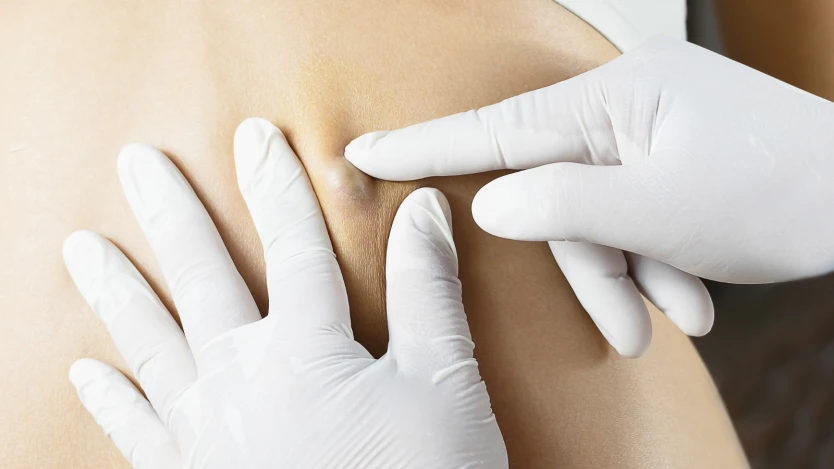What is a lipoma? Causes, diagnosis and possible treatments

- What are lipomas?
- What types of lipomas are there?
- What causes lipomas to appear?
- What are the symptoms of lipomas?
- Diagnosis of lipomas
- How are lipomas treated?
- Request a surgical assessment consultation with Operarme
- A lipoma is a benign tumour that is made up of fatty tissue cells that form adipose tissue.
- They usually occur under the skin. Lipomas can occur anywhere in the body, although they predominate in the neck, trunk and back, and are uncommon in the extremities.
- Treatment of a lipoma is not usually necessary, unless it causes pain, restricts movement or presents characteristics that make one suspect that it is benign. Surgical removal is necessary to resolve it.
What are lipomas?
Lipomas are benign tumours of a soft nature and are formed by adipose tissue cells. Among the characteristics of lipomas are that they are soft to the touch, rounded, well-delineated and usually painless. They can also move when touched, as they are not attached to deep skin planes.

Do you need to surgically remove a lipoma/cyst?
Request a free and immediate appointment with our specialists in General Surgery
Benign tumours of adipose tissue can occur in any location in the body that contains fat. Most occur in the upper half of the body, particularly the trunk and neck; other common sites include the proximal portions of the upper arm, thigh and buttocks.
A lipoma is a slow-growing lump of fat that is usually located between the skin and the underlying muscle layer.
Lipomas commonly develop in adults between 40 and 60 years of age. Their frequency increases with age, although they can also be found in young adults and children, very rarely in the latter.
If many lipomas appear, it is called lipomatosis, and in many cases it is hereditary.
What types of lipomas are there?
Regarding the type of lipomas based on their shape and internal characteristics, lipomas can be fibrolipomas, myxolipomas, chondroids, myolipomas, spindle cell lipoma, angiomyolipoma, lipoblastoma and hibernoma.
The most common are:
- Angiomyolipoma. This is a painful nodule, located under the skin, frequently occurring on the forearm and more common in adults. It can be multiple and can be confused histologically (study of the microscopic structure, composition and function of the tissues) with Kaposi's sarcoma or angiosarcoma.
- Fusocellular lipoma. It is characterised by a painless, consistent nodule usually located on the back and/or neck. This type of lipoma is more common in men between 40 and 75 years of age.
- Polymorphic lipomas. This is a rare lesion with spindle cells (long, thin appearance under the microscope) and lipocytes (cells that form adipose tissue).
- Intermuscular and intramuscular lipomas. These are lipomas that can reach a large size and are generally located in the lower extremities. These lipomas infiltrate the muscle and grow around the peripheral nerves.

You can learn more about lipomas according to their location in the following links:
Single lipomas are more frequent in women while lipomatosis (multiple lipomas) occurs more often in men.
Apart from these types of lipomas, we can classify them as cutaneous (superficial) or deep.
The differences between these types of lipomas are:
- Cutaneous or superficial lipomas: this is when the lipoma is located in superficial soft tissues (subcutaneous cellular tissue, below the skin). They are usually located on the back, shoulders or neck. In less frequent cases, they can also be located on the arms, buttocks or thighs.
- Deep lipomas: they are usually firmer. Their origin is intraosseous, intermuscular and intramuscular. This type of lipoma is less common and their location and growth may go unnoticed. They can be located in places such as the hands, feet, gums, tongue, etc. Although the latter cases are less frequent. They can produce compression symptoms, especially nerve compression, during their growth, as well as limiting mobility.
Do you have any type of lipoma? If you wish to remove one or more lipomas (sebaceous cysts) you can click on the image below and request a free assessment consultation with our specialists:

Do you need to surgically remove a lipoma/cyst?
Request a free and immediate appointment with our specialists in General Surgery
What causes lipomas to appear?
The exact cause of a lipoma is unknown, however, there are factors that can increase the risk of developing a lipoma.
The main factors that tend to lead to the development of one or more lipomas are:
- Family history of lipoma. This factor is only confirmed in the case of lipomatosis (multiple lipomas on the body), generally, this tendency is found among direct relatives and is called multiple familial lipomatosis.
- Due to blows or injuries. Lipomas can appear in places where a blow has been received.
- Obesity or overweight. Given that lipomas are lumps formed by adipose tissue, fat, weight gain greatly favours the formation of lipomas, although this is not conclusive, as they can also appear in people who are slim.
- Alcohol consumption. Excessive alcohol consumption increases the risk of lipomas.
- Medical conditions. Liver disease or high blood glucose levels are conducive to the development of lipomas.
A lipoma can be due to causes as diverse as genes, stroke or obesity.
What are the symptoms of lipomas?
The symptoms of a lipoma are usually nil, as they rarely cause discomfort or pain.
Most of the time a lipoma is discovered when it is palpable and is seen as a soft, rounded lump that moves under the skin. When the lipoma grows very slowly and moves under the skin, it is a benign lipoma.

Diagnosis of lipomas
When diagnosing a lipoma, the specialist may perform different tests:
- Questions about the patient's medical history
- Physical examination
- Biopsy (removal of a sample of tissue from the lipoma)
- Ultrasound scan
These tests will confirm or dismiss whether it is a lipoma or whether there is a possibility that it is a liposarcoma, i.e. a cancerous tumour that grows rapidly, does not move under the skin and is painful. To correctly distinguish one from the other, it is advisable to see a specialist.
Most of these benign tumours do not require treatment, but when they are bothersome and grow rapidly they can be treated with different procedures ranging from steroid injections to removal of the tumour.
How are lipomas treated?
As mentioned above, lipomas are not usually painful or cause complications, so treatment is not always necessary. Lipomas are usually treated when they are painful, restrict movement or simply for cosmetic reasons.

The treatments that exist to eliminate one or more lipomas are simple interventions that can be carried out either by means of corticosteroid injection techniques or liposuction or by means of minor or outpatient surgery, surgical removal.
These treatments consist of:
Liposuction
Lipomas of different sizes can be removed and scarring is avoided. It is performed with a needle and syringe to remove the lump of fat.
With this technique it is difficult for the lipoma to disappear completely. With this procedure, the specialist uses suction and aspiration to remove the lipoma. This is assisted by a small incision through which the liposuctor is inserted.
Does liposuction permanently remove lipomas?
The technique of lipoma removal by liposuction is usually not as effective as the surgical removal of lipomas since, after a more or less long period of time, it is possible for the lipoma to reappear.
Is anaesthesia required?
In very small lipomas, less than 2.5 cm in diameter, it is possible that no anaesthesia is required. In the event that this treatment is used and the lipoma is larger, the specialist may use local anaesthesia.
Generally, lipomas do not require treatment, but if removal is performed, depending on the size and location of the tumour, it may be sufficient to perform a simple surgery under local anaesthesia.
Surgical removal
This is the most commonly used technique to remove a lipoma, as it is the only technique that ensures complete removal of the lipoma.
For the surgical removal of one or more lipomas, the doctor makes a small incision in the skin after having previously anaesthetised the surgical area.
How long does lipoma removal surgery last?
The surgical removal of lipomas is a simple and short operation, lasting between 30 and 60 minutes, depending on each case and the number of lipomas to be removed.
What anaesthesia is used for surgical lipoma removal?
Generally, local anaesthesia is used during lipoma removal surgery.
Is lipoma surgery permanent?
In most cases, lipoma removal surgery has a permanent effect, i.e. the lipomas do not recur in the area over time.
Request a surgical assessment consultation with Operarme
If you would like to request a free assessment consultation with our specialists, you can call at +34 91 141 33 56 or fill in the contact form so that our patient service department can contact you and arrange it.
You can also click directly on the image below to request an appointment:

Do you need to surgically remove a lipoma/cyst?
Request a free and immediate appointment with our specialists in General Surgery
Medical disclaimer: All the published content in Operarme is intended to disseminate reliable medical information to the general public, and is reviewed by healthcare professionals. In any case should this information be used to perform a diagnosis, indicate a treatment, or replace the medical assessment of a professional in a face to face consultation. Find more information in the links below:

